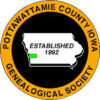Information courtesy of the Douglas-Sarpy Counties [NE] Mormon Trails Assoc.
On February 14, 1846, the first Mormons left Nauvoo, Illinois and headed west on what has become known as the Mormon Trail. After stopping for the winter of 1846-47 at Winter Quarters (now Omaha, Nebraska), they traveled on to what is now Salt Lake City, Utah. The first company of pioneers arrived July 24 in Salt Lake July 24, 1847. It’s estimated that 68,000 pioneers followed the same trail during the next twenty-two years.
“It is good to look to the past to gain appreciation for the present and perspective for the future. It is good to look upon the virtues of those who have gone before, to gain strength for whatever lies ahead. It is good to reflect upon the work of those who labored so hard and gained so little in this world, but out of whose dreams and early plans, so well nurtured, has come a great harvest of which we are the beneficiaries. Their tremendous example can become a compelling motivation for us all, for each of us is a pioneer…and many of us pioneer daily.”
~ President Gordon B. Hinckley,
The Church of Jesus Christ of Latter-day Saints
- The Mormon Trail is 1,032 miles from Winter Quarters (near Florence Nebraska) to Salt Lake City, Utah. The first leg of the journey was from Nauvoo, Illinois, another 265 miles.
- The Mormon Trail was used for twenty-three years, from 1846 to 1869.
- The trail was not a narrow path, but a corridor, depending on the river, available grass, the terrain, events of the year and other factors. It was also a two-way road.
- The Mormon Trail is not an original trail but followed existing territorial and Indian trails. It was blazed by trappers and traders. It followed part of the Ox-Bow Trail, the Oregon and California Trails and the Hastings cut-off into the Valley of the Great Salt Lake.
- The motivations for moving west were unique. The Mormons did not travel west for gold, land, or adventure. They went west in search of religious freedom and to maintain a cultural identity.
- Mormon wagon companies were highly organized. There were captains for groups of hundreds, fifties, and tens. Everyone was expected to follow their leader and to obey the rules. They had a daily routine. There was discipline, hard work, mutual assistance, and devotional practices. As a rule, they did not travel on Sunday.
- Knowing that others would follow, pioneers improved the trail and built support facilities. Some of the ferries they built helped finance the movement. They planted crops, recorded pertinent information such as the topography, latitude, longitude, distances, flora, and fauna.
- Six thousand people died on the trail. The greatest threats to life were illness and accidents. They suffered from poor nutrition and exposure to the elements.
- After 1849 The Perpetual Emigration Fund was established to assist Latter-day Saints coming from the eastern United States and Europe. Church and private contributions were used for these loans. Emigrants signed a note promising to repay as soon as they were able.
- Handcarts were used from 1856 to 1860. Nearly 3,000 immigrants used this method of transportation. They could make 25 to 30 miles per day (wagons traveled only 10 to 15 miles per day on average).
- As the Mormons were preparing to go west, they were approached by the United States government for help in the war against Mexico. The Mormon Battalion was formed with over 500 members near Council Bluffs, Iowa in 1846. They then began a march to San Diego, California, one of the longest marches in military history. They never fought a battle but made history by clearing roads to the west and helping secure California as a U.S. Territory. Some former members eventually participated in the discovery of gold at Sutter’s Mill in northern California.
The Mormon Trail on Wikipedia.
